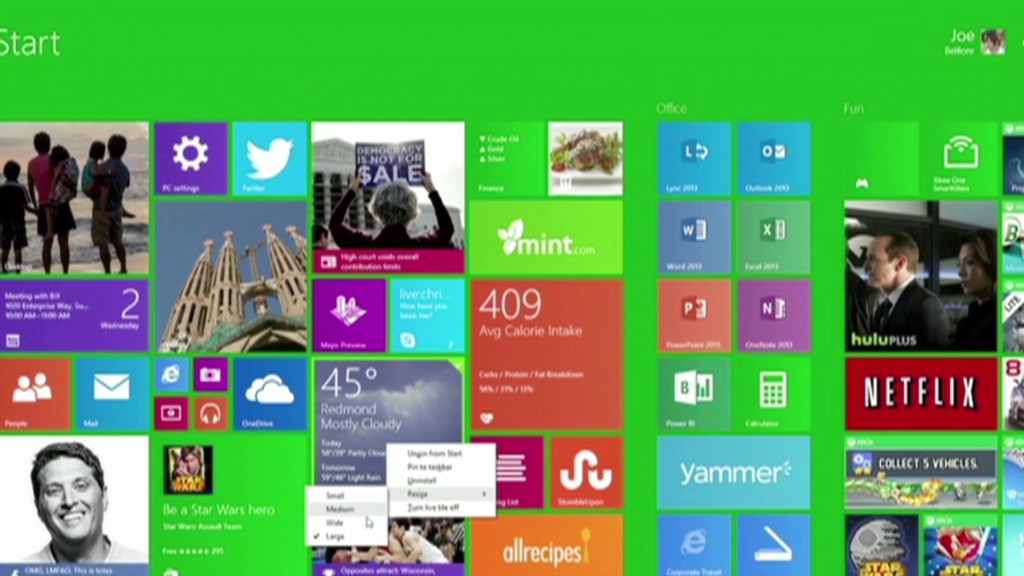
Microsoft will send out a free update to Windows 8.1 next week that will improve the experience for mouse and keyboard users.
Since its release nearly two years ago, Windows 8 has been a work in progress. Microsoft's latest update will get it closer to a finished state.
According to Microsoft (MSFT), the company's goal with its latest update is to further blur the line between the legacy desktop mode, and the "Modern" tile-based interface.
At its annual Build developers conference in San Francisco, Microsoft said many of the changes to Windows 8.1 will address that issue directly -- a problem had has contributed to slumping Windows sales. (Click here to follow our Microsoft Build live blog).
Windows will detect when it is running on a laptop or desktop -- as opposed to a tablet -- and automatically navigate to desktop mode when unlocking the computer. Tablets will still unlock into the tile-based Start screen, however.
When using Modern apps with a mouse and keyboard, there will be a desktop-style title bar that appears at the top of the screen, allowing users to quickly minimize or exit an app.
The taskbar, a staple of the desktop user interface in Windows, will now be accessible from anywhere in the operating system, including the Start screen. When users mouse all the way down to the bottom of the Start screen or a Modern app, the taskbar will float up from the bottom with all their favorite pinned apps.
If you open a Modern app from the desktop mode, it will open the app in the typical full screen mode and behave like a Modern app. But when you close or minimize the app, it will take you back to the desktop.
Related: Meet Cortana, Microsoft's Siri
Modern apps will also be able to be pinned to the taskbar, which should theoretically make it quicker and easier for people who primarily operate out of the desktop interface to access those newer apps.
Microsoft also made a few tweaks to the Start screen and Modern apps meant to help both the mouse and keyboard users -- and also those new to Windows 8.
When someone right clicks on the Start screen, the secondary context menu will more closely resemble what you'd get on the desktop, which adds a layer of familiarity. When new apps are installed, the Start screen will alert how many new apps are waiting for users in the second layers of the menu, in case they weren't aware that the shortcuts were lurking below. And the search and power (restart and shut down) buttons will be more readily accessible from the main Start screen, for anyone unaware of how Microsoft's "charms" work (they're hidden on the right side of the screen.
Related: 5 things we want for Windows 9
There's also a bonus for those using tablets or small hard drives: The Windows 8.1 update will apparently shrink the storage space for the operating system down by 60%, which means more usable drive space.
The update to Windows 8.1 is not as big or major as the Windows 8.1 release was last year, but there are enough refinements here to keep inching it closer to being a true operating system for both tablets and desktops.
One frequently requested feature -- the return of the Start menu button -- isn't part of the new Windows 8.1 release. But it is coming back...some day. Microsoft said it is planning a future update that will bring back a more traditional Start Menu features, as well as the ability to run Modern apps in a window on the desktop.
The Windows 8.1 update will be available as a free download via Windows Update and the Windows Store starting on April 8.
One Windows: Another big initiative for Microsoft is unifying its PC, mobile, Xbox and Kinect platforms Windows Phone and Windows will remain separate platforms, but moving forward, they will be able to run the same Modern-style apps.
The biggest benefit of this shift is clearly for app developers, who won't have to spend resources developing two completely different apps. But there's also consumer benefit: Since these new cross-platform apps will come in one universal package, users can purchase an app once and install across all their Windows devices. Furthermore, any in-app purchases will also be saved across multiple devices.
As more developers shift from making PC apps to these new, cross-platform Modern apps, it's easy to imagine a day in the near future when you could dock a smartphone to a monitor, mouse, and keyboard and get a near-PC experience.

